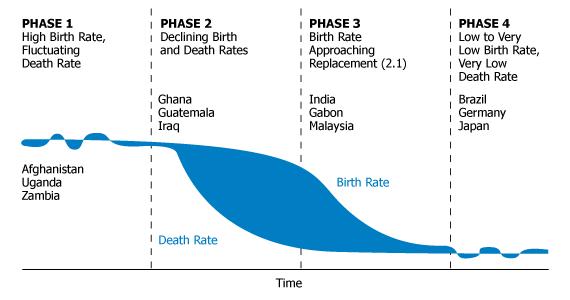Demystifying the Demographic Dividend
Aug 9th, 2012 | By admin | Category: Economics and GDPBy Suzanne York, HowMany.org.
Over half the world’s population of 7 billion people is age 25 or under. The opportunities we provide these youths, and the choices they make – especially in terms of health, education, and jobs – will make a huge difference in our future, including whether global population rises to 10 billion people by 2050 or stops at around 8 billion.
The LA Times recently ran an in-depth series on population, with one analysis taking into account youth and frustrations over lack of employment opportunities and how it can contribute to global insecurity. As society comes to term with the needs of this generation and the implications of such a “youth bulge”, expect to hear more about the importance of terms like the demographic dividend.
The demographic dividend is described as an opportunity that arises when a country transitions from high to low rates of fertility and child and infant mortality. This transition creates a generation that is significantly larger than the generations immediately preceding and following it. As this group hits working age, they have the potential to enter into productive economic activities and invest savings, thus spurring heightened economic growth. A more detailed explanation can be read at Population Reference Bureau.
Here is a simplification of how demographers look at the stages of a nation’s demographic transition:
Phase 1 – high fertility/high mortality
Phase 2 – death rates fall rapidly, rising population
Phase 3 – birth rates fall, death rates fall, rising population, labor force bulge
Phase 4 – low fertility/low mortality
This past June in Rio de Janeiro, the UN Conference on Sustainable Development dedicated a side event to discussing the demographic dividend. Peggy Clark of the Aspen Institute stated that a country with a large youth population can realize a demographic dividend if it invests in improving child survival rates, increasing access to reproductive health, increased access to education, and job creation. As child mortality and fertility rates decrease, the former youth bulge becomes a bulge of working-age population (whereby the working population experiences a significant gain in benefits). Clark said that in the Asian Tiger countries (South Korea, Hong Kong, Singapore, and Taiwan), 1/3rd of the economic growth since 1970 can be attributed to the demographic dividend.
Susan Reichle, Assistant to the Administrator for USAID’s Bureau of Policy, Planning and Learning, said that with 40% of the population in developing countries under the age of 20, it should be seen as a challenge that can be turned into an opportunity. She also pointed to the Asian tigers as an example of how investments in family planning and youth changed the population pyramid.
Today it is Africa, with its growing economies, a median age of 18, and a population projected to increase from 1 billion to 2 billion by 2050, where the demographic dividend may come into play. Cassio Turra, a Brazilian demographer, said that Africa can take advantage by looking at other areas that had large youth populations and see what did and did not work. It is critical that countries have the right policies in place, including economic adjustments to allow economies to grow (which can be a blessing or curse), good economic measures, investments in education, women’s empowerment and health, and also policies that combat corruption. “As soon as you can implement these, the more you will get from dividend”, Turra stated.
Reichle noted that governance matters and that demography does not equal destiny. Countries have to make investments early on in child survival, family planning, and access to education – especially education of girls – which will reap greater dividends. An integrated approach is important, with investments in vocational training and infrastructure also needed. Even if all this happens in Africa, she said, “we have a long way to go if we are to change the dynamics so there is a dividend.”
Carmen Barroso, of International Planned Parenthood Federation, stressed that it is necessary to pay attention to existing inequalities and the need for contraceptives by youth. To keep population numbers stable, the large number of young people must also delay having their first child.
Linah Mohohlo of Botswana succinctly stated the demographic dividend potential in an article for the UK Guardian. She wrote “If we can get this right and harness the incredible creativity, energy and innovation in our young people, we can reap a fantastic demographic dividend. But it is not guaranteed.”
With all the scrutiny lately on family planning, the potentials of the demographic dividend should not be ignored. It highlights the urgency of recognizing basic rights, improving access to resources equitably and efficiently, and increasing investment in youth for the benefit of all society.
Suzanne York is a senior writer with the Institute for Population Studies/HowMany.org


